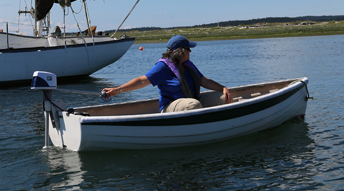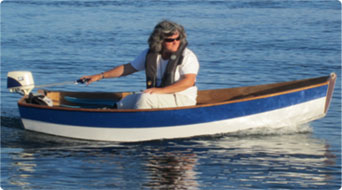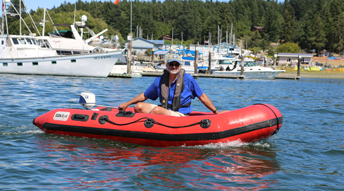Curious how the EP Carry outboard will perform on your dinghy or small boat? We’ve created a boat speed and range calculator to help answer that question.
Speed |
|||
|
Full throttle speed
(knots)
0.0
|
Half-throttle speed
(knots)
0.0
|
||
Range |
|||
|
Full throttle range
(nautical miles)
0.0
|
Half-throttle range
(nautical miles)
0.0
|
||
Type 1

Use the type 1 category for traditional style rowboats, dories with a broad transom, and skinny sailboats like sailing catamarans. Other rigid-hull types should use the "type 2" designation.
Type 1 hulls are designed for efficiency which comes from a relatively long waterline/ overall length ratio, a narrow waterline beam, a clean entry, and a flatter run aft. They take weight well and are comparatively dry in rough conditions. This category often displays low initial stability but generous reserve stability. In other words, it may feel unstable at first, but their resistance to leaning increases as the lean angle increases.
Type 2

Use this category for prams, double enders like peapods, kayaks and canoes.
Type 2 hulls are characterized as having more buoyancy in the middle compared to type 1. This can come from a generous rocker as you will find in a pram, or having two pointy ends like a pea pod, canoe or kayak. While this type of hull is very efficient and seaworthy they produce a higher resistance when driven above "hull-speed".
Type 3

Type 3 hulls is a category just for inflatable dinghies. These include RIBs, inflatable floor, and aluminum slat, and plywood floor types, both pointy in the front as well as the new "catamaran" types. On all modern inflatables, the transom is positioned forward of the aft tube ends. This shortens the LWL resulting in the lowest speed relative to boat length for all types listed. All inflatable styles produce similar speeds for their lengths, but RIBs track better in a turn or crosswind. For all inflatables, max speed is particularly weight sensitive and they can be wet in rough conditions, but considering their generous initial stability, inflatables are the comfy choice for families or those who want that extra stable feel.
We promise our speed predictions are at least within +- 10% on speed and range (see assumptions below). Here are some comparisons of predictions vs. measurements:
| • 7.5 ft Eastport Pram by CLC | - 300 lb. | 3.4 knots measured, 3.3 knots predicted is 3% low |
| • 9 ft Minto rowing sail/row | - 340 lb. | 3.9 knots measured, 3.7 knots predicted is 5% low |
| • 9 ft Riken Inflatable dinghy | - 250 lb. | 3.4 knots measured, 3.4 knots predicted is equal |
| • 10 ft Walker Bay rowboat | - 450 lb. | 3.6 knots measured, 3.7 knots predicted is 3% high |
| • 12 ft Gig Harbor sail/row | - 520 lb. | 3.9 knots measured, 3.9 knots predicted is equal |
| • 12.5 ft Jackson fishing kayak | - 260 lb. | 4.2 knots measured, 4.0 knots predicted is 5% low |
Customers report being impressed with their performance on the first outing*.
If your application is for a boat longer than 13ft or heavier than 600lb loaded, Please contact us
before purchase to make sure EP Carry is a good fit for your needs.
Predictions made using the calculator assume normal standard power firmware*. Values are provided for calm conditions, with weight balanced front to back and from side to side. Speed and range is reduced/increased by wind, seas and currents. See FAQ for more info.
* EP Carry offers a free firmware upgrade to 25% more power that may be appropriate for driving boats over 13ft and 600 lb (see Update Firmware). You can install this yourself using a smart phone.